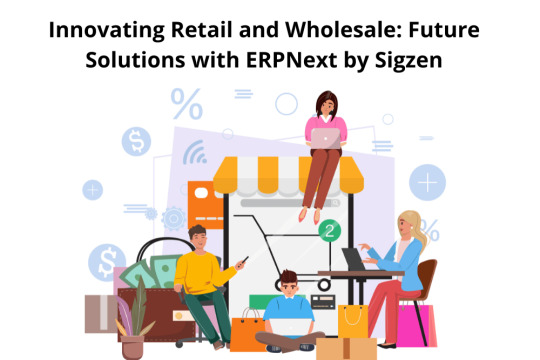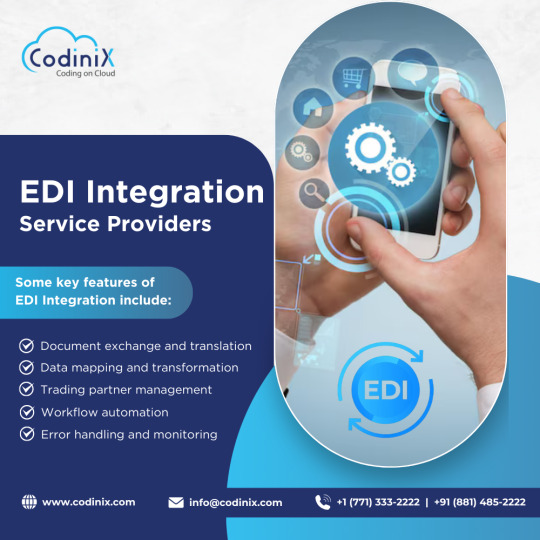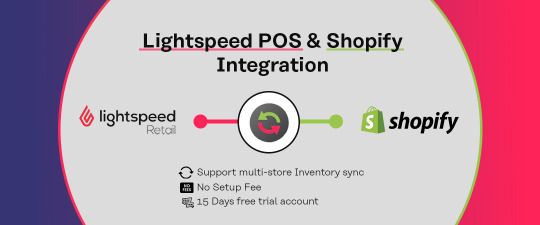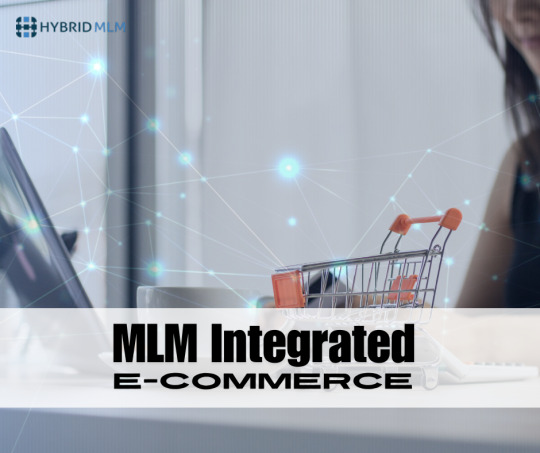#eCommerce integration
Explore tagged Tumblr posts
Text
The Future of Retail & Wholesale: Innovate with ERPNext Solutions by Sigzen
In the dynamic landscape of retail and wholesale, businesses are constantly seeking innovative solutions to stay ahead. Enter ERPNext, a comprehensive enterprise resource planning (ERP) platform designed to revolutionize operations in both retail and wholesale sectors. With its user-friendly interface and powerful features, ERPNext offers a seamless solution for managing inventory, optimizing…

View On WordPress
#Cloud ERP#Customer Experience#Data Analytics#Ecommerce Integration#ERPNext Solutions#Future of Retail#Retail Technology#Retail Trends#Supply Chain Optimization#Wholesale Innovation
2 notes
·
View notes
Text
Supercharge Your E-commerce Operations with Odoo Shopify Integration
🚀 Supercharge Your E-commerce with Odoo + Shopify! 🛒
Struggling to manage orders, inventory, or customer data across platforms? 💡 Discover how Odoo Shopify Integration brings it all together — syncing your systems, automating workflows, and boosting accuracy.
✅ Real-time inventory sync ✅ Streamlined accounting & CRM ✅ Advanced analytics & reporting ✅ Faster fulfillment, happier customers
✨ Future-proof your eCommerce business with smart integration. 👉 Read our full guide now & unlock operational excellence!
🔗 https://www.candidroot.com/blog/our-candidroot-blog-1/odoo-shopify-integration-780
#odoo#shopify#odoo integration#odoo shopify integration#ecommerce integration#business automation#erp#erpsoftware#odoo erp#odoo services#erp system
0 notes
Text
Connect Lightspeed POS with Liquor Max

Running a liquor store? Now you can automate product, inventory, and order sync between your Lightspeed POS and the Liquor Max eCommerce platform with Octopus Bridge by 24Seven Commerce.
🚀 Eliminate manual updates 📦 Real-time inventory accuracy 💻 Streamlined online & in-store operations 🍾 Designed exclusively for liquor retailers
Octopus Bridge empowers your store to go omnichannel — fast, simple, and smart.
🔗 Learn more: https://www.24sevencommerce.com/liquor-max-integration.html
0 notes
Text
The Importance of Marketplace Integration for Designer Brand Suppliers: Luxury Distribution’s Approach
In today’s fast-paced digital world, businesses are constantly looking for new ways to streamline their operations and reach more customers. One of the most effective solutions for designer brand suppliers is marketplace integration. Luxury Distribution, a leading supplier of premium designer brands, understands the power of marketplace integration and is dedicated to helping retailers and suppliers maximize their potential in the competitive fashion industry.
What is Marketplace Integration for Designer Brand Suppliers?
Marketplace integration for designer brand suppliers refers to the process of connecting a supplier’s inventory and order management systems with popular e-commerce platforms such as Amazon, eBay, or other niche fashion marketplaces. This integration allows suppliers to manage their products, pricing, and orders across multiple platforms from a centralized system, ensuring consistency and accuracy across all sales channels.

For designer brand suppliers like Luxury Distribution, marketplace integration simplifies the process of listing and selling products online, while also making it easier for retailers to access and sell premium products from top-tier brands.
Streamlined Inventory Management
One of the key benefits of marketplace integration for designer brand suppliers is efficient inventory management. Without integration, suppliers may struggle to keep track of stock levels, especially when selling across multiple platforms. Manual updates can lead to errors, stockouts, or overselling, which can negatively impact both the supplier and the retailer’s reputation.
By integrating with major marketplaces, Luxury Distribution ensures that inventory levels are updated in real-time, so retailers can always access the most accurate product availability. This reduces the risk of miscommunication and enhances the overall efficiency of the supply chain, making it easier for retailers to manage their product offerings and provide a seamless customer experience.
Increased Reach and Sales Potential
Marketplace integration for designer brand suppliers opens up new opportunities to expand your customer base. By connecting with multiple online marketplaces, suppliers like Luxury Distribution gain access to a global audience of potential customers. These platforms attract millions of visitors every day, many of whom are actively searching for high-quality designer items.
For designer brands, this integration allows them to capitalize on the existing traffic of these marketplaces while also providing the tools necessary to manage their online presence effectively. Retailers benefit by gaining access to a wider range of products from reputable designers, enhancing their own inventory with premium goods that customers desire. As a result, the potential for increased sales and visibility grows exponentially.
Conclusion
Marketplace integration for designer brand suppliers is essential in today’s digital retail environment. For Luxury Distribution, it represents an opportunity to enhance inventory management, increase sales, and offer a seamless experience for both retailers and customers. By embracing the power of marketplace integration, suppliers can scale their operations, reach new customers, and improve their competitive edge in the luxury fashion market. Whether you are a designer brand supplier or a retailer, integrating with popular marketplaces can unlock new opportunities and drive business growth in the fast-paced world of online commerce.
#marketplace integration for designer brand suppliers#marketplace integration#designer brand suppliers#ecommerce integration#multi channel retail#brand management#supplier marketplace#omnichannel integration#b2b marketplace integration#supply chain optimization#e commerce platform integration#designer Brands wholesale#designer brand Drop shipping#designer brands dropshipping#designer brands drop-shipping
0 notes
Text

🚀 Reliable EDI Integration Service Providers! 📊🔗
Say goodbye to manual data entry and errors! Codinix helps businesses exchange data accurately and securely with easy-to-use EDI integration services.
✅ Faster and error-free transactions ✅ Secure and industry-compliant solutions ✅ Built to fit your business needs ✅ Stronger connections with partners
Let your business work smarter with Codinix – your trusted EDI integration service provider! 💡✨
🔗 Learn more: https://codinix.com/edi-integration
#edi integration#electronic data interchange#b2bintegration#supply chain management#data integration#business automation#cloud edi#digital transformation#ecommerce integration#trading partner integration
0 notes
Text
E-commerce Integration: Challenges and How to Overcome Them
Seamless eCommerce integration is the backbone of modern retail, ensuring real-time data flow between sales channels, inventory, order management, and customer databases.
However, many retailers struggle with technical issues, operational inefficiencies, and system incompatibility.
Let’s explore the biggest challenges in eCommerce integration and how businesses can overcome them.
Challenge 1: Managing Multiple Sales Channels
Retailers today sell on various platforms—Amazon, Flipkart, Shopify, and physical stores. However, keeping data synchronized across multiple channels is challenging.
Problem:
Inventory mismatches across platforms.
Inconsistent pricing and product details.
Difficulty managing multiple orders in real time.
Solution:
Implement a unified eCommerce integration platform that syncs inventory and pricing across all sales channels.
Use automated order processing to reduce manual errors.
Challenge 2: Handling Real-Time Inventory Updates
Customers expect accurate stock availability, but poor inventory management can lead to stockouts or overselling.
Problem:
Outdated stock levels across platforms.
Increased risk of canceled orders and refunds.
Poor customer experience due to unavailable items.
Solution:
Utilize real-time inventory tracking tools to auto-update stock levels.
Integrate a centralized order management system to prevent overselling.
Challenge 3: Data Silos and System Compatibility
Retailers use multiple systems like POS, ERP, CRM, and accounting software, but lack of integration leads to data silos.
Problem:
Data fragmentation across different platforms.
Increased manual work to transfer data.
Delayed business insights due to unconnected systems.
Solution:
Choose API-driven eCommerce integration for seamless data exchange.
Invest in an all-in-one ERP system that connects all business functions.
Challenge 4: Order Processing and Fulfillment Delays
A disconnected fulfillment system can slow down shipping, leading to negative customer reviews.
Problem:
Slow order processing due to manual workflows.
Inaccurate delivery tracking.
Increased return rates due to errors in fulfillment.
Solution:
Implement automated order processing software for faster fulfillment.
Use real-time tracking and logistics integration to improve delivery accuracy.
Challenge 5: Security and Compliance Issues
Handling large volumes of customer data, transactions, and tax regulations comes with risks.
Problem:
Risk of cyberattacks and data breaches.
Difficulty managing tax compliance for multiple regions.
Fraudulent transactions impacting revenue.
Solution:
Use secure payment gateways with fraud detection.
Integrate GST-compliant software to automate tax calculations.
How GinesysOne Simplifies eCommerce Integration
GinesysOne provides a unified retail integration solution, helping businesses: - Seamlessly sync sales channels, inventory, and payments.- Automate order fulfillment for faster deliveries. - Ensure data security & tax compliance across platforms.
Ready to streamline your eCommerce operations?
GinesysOne has the right tools to help!
0 notes
Text
0 notes
Text
Shopify integration with Dynamics 365 Business Central
Integrating Shopify with Dynamics 365 Business Central is a powerful way to streamline eCommerce operations and enhance overall business efficiency. By connecting these two platforms, businesses can sync orders, inventory, and customer data seamlessly, reducing manual entry and the potential for errors. When an order is placed on Shopify, the information can be automatically pushed to Business Central, where it can be processed, invoiced, and tracked. Likewise, inventory levels in Business Central can be updated in real-time on Shopify, ensuring customers are only shown products that are in stock. This integration allows businesses to save time, improve order accuracy, and provide a better experience for their customers.
Beyond improving operational efficiency, this integration also enhances financial management and reporting. Sales data from Shopify can be transferred directly into Business Central, allowing finance teams to generate real-time financial reports and manage cash flow effectively. The integration helps ensure that all sales transactions, including taxes and shipping, are accurately recorded in Business Central's general ledger. This seamless flow of data between Shopify and Dynamics 365 Business Central empowers businesses to scale, automate processes, and make data-driven decisions without worrying about discrepancies between their eCommerce platform and back-office systems.
Click here to know more: https://www.intelegain.com/shopify-integration-with-dynamics-365-business-central/
#Shopify integration#Dynamics 365 Business Central#eCommerce integration#Shopify and Business Central sync#Automating Shopify orders#Inventory management integration#Financial management with Shopify#Real-time inventory updates#Business Central financial reports#Shopify ERP integration#Order processing automation#Shopify Dynamics 365 integration benefits#Business efficiency with Dynamics 365#Syncing Shopify with ERP#Shopify Business Central automation
0 notes
Text
0 notes
Text
Key Insights for Optimizing BigCommerce and Lightspeed Integration
In today’s fast-paced retail landscape, streamlining e-commerce and in-store operations is essential for business success. For businesses using both Lightspeed POS and BigCommerce, integrating these two powerful platforms can help bridge the gap between online and offline operations, offering seamless inventory management, order processing, and customer engagement. Effective integration of…

View On WordPress
#Bigcommerce Integration#eCommerce Integration#eCommerce POS integration#Lightspeed and Bigcommerce Integration#Lightspeed Bigcommerce Integration#Lightspeed Integration#Lightspeed Integration with Bigcommerce
0 notes
Text
MLM Integrated E-Commerce: A High-Yield Collaboration for Business Profitability

In today’s business world, combining Multi-Level Marketing (MLM) with E-Commerce is emerging as a powerful strategy for maximizing profitability. This collaboration merges the personal, relationship-driven aspects of MLM with the scalability and convenience of E-commerce, creating a high-yield business model.
Understanding MLM and E-Commerce
MLM relies on direct selling through a network of distributors, who earn commissions from their sales and the sales of their recruits. The structure allows for exponential growth as new distributors join and expand the network.
Ecommerce, on the other hand, refers to selling products or services online, providing businesses with access to a vast customer base and streamlined, low-cost operations. The rapid rise of digital commerce has made it a vital tool for modern businesses.
Benefits of MLM and Ecommerce Integration
1. Expanded Sales Reach
Combining MLM with Ecommerce allows businesses to reach a global audience. Distributors can sell products online and recruit new members from different regions, extending their influence far beyond local markets.
2. Lower Costs
Ecommerce reduces overhead expenses, eliminating the need for physical storefronts and streamlining inventory management and shipping. This allows MLM businesses to operate with lower costs while increasing profitability.
3. Automation
Ecommerce platforms provide tools to automate marketing and sales processes, such as lead generation, customer follow-ups, and personalized campaigns. MLM distributors can use these tools to increase efficiency and focus on recruiting and selling.
4. Customer Retention
MLM’s focus on building personal relationships aligns well with Ecommerce’s ability to create loyalty programs and offer subscription services. This encourages repeat purchases and fosters customer loyalty, driving long-term profitability.
Synergies for Profitability
Integrating MLM with Ecommerce enhances scalability and global reach. Distributors can manage larger networks with minimal infrastructure while using Ecommerce tools to increase sales and conversions. The ease of entry for new participants, combined with low overhead costs, makes this model particularly attractive for entrepreneurs.
Challenges of Integration
Despite the advantages, there are challenges. MLM's reputation has often been scrutinized due to concerns about unethical practices. Ensuring transparency and ethical operations is critical to avoiding skepticism. Additionally, balancing recruitment with product sales can be difficult. MLM companies must prioritize sales over recruitment to avoid legal and reputational risks.
Regulatory compliance is another issue, as Ecommerce introduces complexities, especially when operating across borders. Ensuring the business adheres to both MLM and ecommerce regulations is essential for sustainability.
Future Trends As social commerce and influencer marketing continue to rise, MLM E-Commerce integration is poised to benefit from these trends. Personal recommendations from influencers align perfectly with MLM’s word-of-mouth model. Additionally, advancements in AI and big data analytics will allow distributors to optimize their sales strategies, enhancing customer targeting and increasing conversion rates.
Conclusion
MLM integrated with e-commerce offers businesses the opportunity to scale globally, reduce costs, and drive higher sales and conversions. This collaboration is an effective way to increase profitability while leveraging the strengths of both models. However, success requires addressing challenges related to reputation, compliance, and network management. The future looks bright for businesses that embrace this high-yield collaboration.
#mlm#mlm software#mlm business#networkmarketing#affiliate marketing#mlmbusiness#multilevelmarketing#mlm companies#ecommerce integration#ecommercebusiness#mlmecomemerceintegration#ecommerce#network marketing business#networkmarketingsoftware
0 notes
Text
Paws and Profits: A Pets Store’s Tale of Integration Success
In the heartwarming world of pet supplies, providing top-quality products while managing efficient operations is essential. For a pets store that prided itself on offering everything from nutritious pet food to cozy bedding and fun toys, integrating Retail Pro point of sale system with their Amazon store through Octopus Bridge marked a turning point in their business.
Located in a pet-loving community, the store was a favorite among local pet owners. Their Amazon store, however, allowed them to reach pet enthusiasts far beyond their immediate vicinity. Despite the success of their online presence, the retailer faced significant challenges in managing inventory and pricing across both their physical and online stores.
Before the integration, inventory discrepancies were a common issue. Stock levels and prices on Amazon often didn’t match those in the physical store, leading to customer frustration and lost sales. Manual updates were labor-intensive and error-prone, taking time away from more strategic business activities.
The integration of Retail Pro with Amazon through Octopus Bridge brought about a remarkable change. Near real-time synchronization of inventory and pricing information ensured that stock levels were always accurate across both platforms. This eliminated the risk of overselling or underselling, providing a more reliable and satisfying shopping experience for customers.
Automating the process of downloading Amazon orders into the Retail Pro POS system also streamlined operations. Previously, staff had to manually input online orders, which was time-consuming and often led to errors. With the integration, Amazon orders were automatically recorded in Retail Pro, allowing for faster and more accurate order processing.
This seamless flow of data had multiple benefits. With accurate inventory information, the retailer could better manage their stock levels, ensuring popular products were always available while avoiding overstocking less popular items. They could also implement more effective pricing strategies, responding quickly to market trends and competitor pricing.
Customer satisfaction improved significantly. Accurate stock levels displayed on Amazon meant customers could shop with confidence, knowing that the items they ordered were available and would be delivered promptly. The streamlined order processing reduced delivery times, enhancing the overall customer experience.
Moreover, the integration allowed the retailer to focus more on customer engagement and service. With operational tasks automated, staff had more time to interact with customers, both in-store and online, providing personalized assistance and building stronger relationships. The retailer also used the integration to gather valuable customer feedback, informing product development and service improvements.
Marketing efforts also benefited. With more time freed up from manual inventory management, the retailer could focus on promotional activities. They launched targeted marketing campaigns on Amazon, highlighting new arrivals and special offers, which drove traffic and sales. In-store promotions were also better coordinated with their online activities, creating a cohesive shopping experience for their customers.
In summary, the integration of Retail Pro POS with Amazon through Octopus Bridge enabled the pets store to streamline operations and enhance customer service. By automating inventory updates and order processing, the retailer could focus on strategic initiatives that drove growth and customer satisfaction. This seamless integration proved to be a vital tool in their journey to success, helping them achieve greater efficiency and profitability in the competitive world of pet supplies.
0 notes
Text
#microsoft#microsoft dynamics nav#microsoft dynamics 365#crm#customer relationship management#ecommerce#ecommerce integration
0 notes
Text
#ecommerce integration#ecommerce integration platform#ecommerce fulfillment services#fulfillment for ecommerce#e commerce solutions services#e commerce order management
0 notes
Text
Shopping Cart Integration Software: Key Features to Boost Sales
In today’s competitive eCommerce landscape, shopping cart integration software is no longer optional—it’s essential. A well-integrated system ensures seamless transactions, enhances customer experience, and ultimately increases conversions. Let’s explore the key features that drive sales and efficiency.
1. Seamless Multi-Platform Integration
A great shopping cart integration software connects effortlessly with multiple eCommerce platforms, including Shopify, Magento, WooCommerce, and custom-built websites.
Why it matters?
Expands sales channels while maintaining a single inventory.
Reduces manual work by automating order processing.
2. Real-Time Inventory Synchronization
When customers see an item available on your site, they expect it to be in stock.
Real-time inventory syncing prevents overselling and stockouts.
Auto-updates inventory across all selling platforms.
Eliminates discrepancies between online and offline stock.
Example: A retailer selling on Amazon, Flipkart, and their own website can maintain a centralized inventory without worrying about mismatched stock levels.
3. One-Click Payment Gateway Integration
An integrated shopping cart must support multiple payment options like credit cards, UPI, wallets, and BNPL (Buy Now, Pay Later).
Supports multiple payment gateways (Razorpay, PayPal, Stripe, etc.).
Reduces abandoned carts by offering a smooth checkout process.
4. Automated Tax and GST Compliance
Tax calculation errors can be costly. Advanced shopping cart software auto-calculates GST, VAT, and regional taxes based on customer location.
Why it’s a game changer?
Reduces compliance risks.
Saves time for businesses handling multi-region taxation.
5. Personalized Customer Experience
Modern cart integration goes beyond transactions—it personalizes the journey.
Recommends products based on browsing history.
Saves customer preferences for faster checkouts.
Automates abandoned cart recovery emails to bring customers back.
Result: Higher conversion rates & increased customer retention.
6. Omnichannel Order Processing
Retailers selling through multiple channels (marketplaces, social commerce, offline stores) need a centralized order management system.
Processes orders from various platforms in one dashboard.
Provides customers with real-time order tracking.
Example: A business selling on Instagram, Amazon, and its website can process all orders from one place.
7. Mobile Compatibility for On-the-Go Sales
A robust shopping cart system should be mobile-friendly.
Benefits:
Customers can shop from any device without glitches.
Retailers can track sales, process orders, and manage inventory remotely.
How GinesysOne Powers Smart Shopping Cart Integrations
With GinesysOne, retailers can unlock a seamless shopping cart experience with: - End-to-end eCommerce integration—syncing online and offline sales. - Advanced payment & tax automation to simplify compliance. - Personalized customer engagement tools to enhance shopping experiences.
Sell smarter, not harder.
Let GinesysOne take your shopping cart integration to the next level!
#shopping cart integration#shopping cart integration software#ecommerce integration#order management system
0 notes
Text

Bluemeteor dataxchange for communities & ecosystems - get the data where you are & create real-time dashboards!
The platform allows to leverage a standardized template for product information to accelerate and simplify data exchange and digital transformation by providing you a cloud-based platform that enables the exchange of rich product content between stakeholders. Why bluemeteor dataxchange? - It eliminates the barriers using a machine monitoring system, scaling for growth & expandability & offering on-premise installation.
#databridge#data intelligence#data integrity#master data management#content syndication#product data#syndication#pim ecommerce#ecommerce integration#vendor portal
0 notes